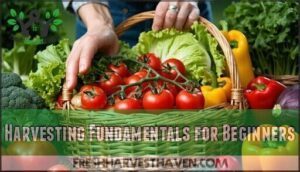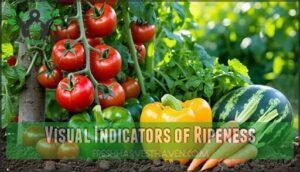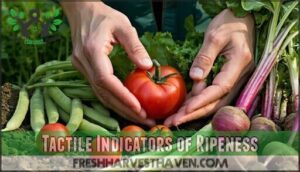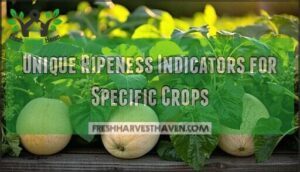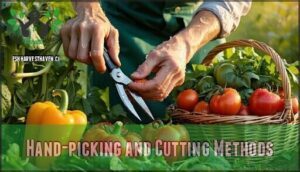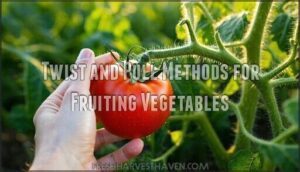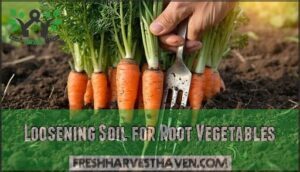This site is supported by our readers. We may earn a commission, at no cost to you, if you purchase through links.
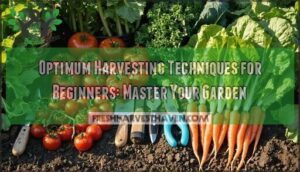
You’ll need essential tools: sharp harvesting knives, proper storage baskets, and clean shears for different crops.
Learn to read ripeness through visual cues like color changes and tactile indicators such as gentle give when pressed.
Use appropriate methods—twist-pull for peppers, cut herbs cleanly, and carefully loosen soil around potatoes.
Proper post-harvest handling maximizes both flavor and storage life while keeping plants productive all season long.
Table Of Contents
- Key Takeaways
- Harvesting Fundamentals for Beginners
- 6 Best Harvesting Tools for Beginners
- Identifying Ripeness in Various Crops
- Effective Harvesting Techniques for Different Produce
- Post-Harvest Handling and Storage Tips
- Frequently Asked Questions (FAQs)
- How to harvest your crops effectively?
- How can I maximize harvest quality & quantity?
- How do I plan my harvest time?
- What equipment do you need to harvest a crop?
- How do farmers determine the best time for harvesting?
- What should I know about harvesting?
- What are the three main methods of harvesting?
- What time of day is best for harvesting?
- What are the good harvesting practices?
- What are the 4 stages of harvesting?
- Conclusion
Key Takeaways
- Time your harvests perfectly – You’ll get the best flavor and nutrition by picking tomatoes when they’re fully colored but firm, harvesting lettuce during cool morning hours, and waiting for root vegetables to sweeten after a light frost.
- Master the visual and tactile cues – You’ll know produce is ready when you see color changes, feel the right firmness (a slight give without mushiness), and notice size indicators like thumb-thick carrots or full-sized melons.
- Use proper harvesting methods for each crop – You’ll prevent damage by using the twist-pull technique for peppers, cutting herbs cleanly with sharp tools, and gently loosening the soil around root vegetables with a garden fork.
- Handle and store correctly after harvest – You’ll maximize shelf life by harvesting during cool morning hours, cleaning produce gently, controlling humidity and temperature during storage, and separating ethylene-producing fruits from sensitive vegetables.
Harvesting Fundamentals for Beginners
You’ll discover that successful harvesting hinges on recognizing the precise moment when your crops reach peak maturity, combining visual cues with tactile assessment techniques.
Understanding how timing, weather conditions, and proper handling directly impact your produce’s nutritional value and storage life transforms you from a casual gardener into a skilled harvester who maximizes both yield and quality, by applying the right techniques at the right moment to achieve peak maturity.
Importance of Timing in Harvesting
When you nail the timing, you’ll achieve ideal ripeness and maximize flavor in every harvest.
Your plants reach peak maturity when visual signs of maturity align with proper harvesting timing—think vibrant tomato colors or firm cucumber texture.
Harvesting techniques that focus on these indicators help prevent spoilage while ensuring yield optimization.
You’ll avoid pest avoidance issues by picking before insects strike, and your harvesting tips will center on recognizing plant maturity markers.
Smart harvesting timing transforms average produce into exceptional crops with superior taste and nutrition.
It also helps in recognizing plant maturity markers and achieving superior taste.
Factors Affecting Produce Quality and Shelf Life
Your harvest timing sets the stage for everything that follows, but several factors determine whether your produce maintains peak vegetable quality and shelf life after leaving the garden.
Timing your harvest right transforms ordinary crops into exceptional produce with superior taste and nutrition.
Storage Temperature dramatically affects decomposition rates, while Humidity Control prevents wilting and maintains texture. Physical Damage during harvesting creates entry points for Microbial Growth, and Ethylene Production from certain fruits accelerates ripening in nearby produce.
- Harvest during cool morning hours when crop maturity indicators appear
- Handle produce gently using proper harvesting techniques to minimize bruising
- Maintain ideal storage temperatures specific to each crop type
- Control humidity levels and separate ethylene-producing fruits from sensitive vegetables
To maximize yields, consider precise cutting techniques for continued production.
6 Best Harvesting Tools for Beginners
You’ll need the right tools to make harvesting efficient and protect your hard-earned produce from damage.
These six essential harvesting tools will help you gather crops at peak ripeness while maintaining quality and extending shelf life, which is crucial for efficient harvesting.
1. Fiskars Harvesting Knife Serrated Edge
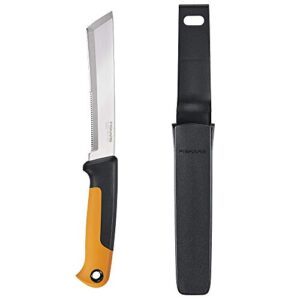
When you’re ready to tackle thick stalks and fibrous stems, the Fiskars harvesting knife with serrated edge becomes your garden’s best friend.
This precision-ground stainless steel blade combines a flat tip for clean push cuts with serrated edge uses for tough, woody material. Harvesting techniques for beginners improve dramatically with proper harvesting tools like this one.
The ergonomic design reduces hand fatigue during extended harvest sessions, while blade sharpness stays consistent through multiple growing seasons. Fiskars durability shines in outdoor conditions, though the included sheath may crack in freezing weather.
At $17.41, this versatile knife handles everything from herb harvesting to cutting twine. Knife maintenance involves simple cleaning and occasional sharpening. Whether you’re perfecting harvesting techniques or just starting your garden journey, this reliable tool delivers professional results without breaking the bank.
2. Berry Picker Rake Easy Harvest Tool
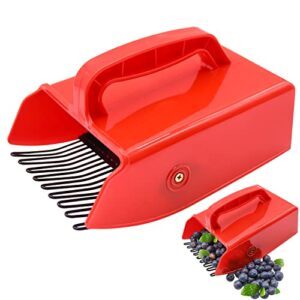
While a quality harvesting knife handles precision work, you’ll want something different for small berries.
A berry picker rake transforms tedious hand-picking into an efficient process that saves both time and your back.
This comb-like tool features tines that gently separate berries from branches while you work.
The rake efficiency comes from collecting multiple berries simultaneously without the berry damage common with rushed hand-picking.
User ergonomics matter here—the extended handle keeps you upright, reducing strain during longer harvesting sessions.
The raised collection rim prevents spillage, though expect some leaves mixed with your harvest.
Tool maintenance is simple: rinse after use and check tines for damage.
While alternative tools like handheld scoops exist, this rake offers superior harvesting efficiency for blueberries, elderberries, and similar small fruits.
Best For: Beginner and experienced gardeners seeking efficient, ergonomic harvesting tools for small berries without the mess of traditional fruit pickers.
3. Woven Garden Harvest Basket Foraging
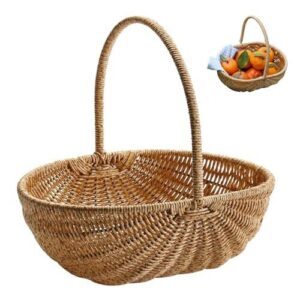
Your garden harvest basket becomes an invaluable partner when you’re ready to collect your fresh produce.
This woven companion transforms harvesting techniques for beginners into an organized, efficient process that protects delicate vegetables while you work through your rows.
These versatile containers excel at vegetable harvesting because their breathable construction prevents moisture buildup that can damage tender crops.
The ergonomic design reduces strain during extended garden harvest sessions, while basket capacity accommodates everything from cherry tomatoes to leafy greens.
Key benefits of quality harvest baskets include:
- Basket durability – Sturdy construction withstands regular use and weather exposure
- Foraging ethics – Encourages sustainable collection practices through proper sizing
- Basket weaving craftsmanship guarantees air circulation for produce freshness
- Ergonomic design features comfortable handles that distribute weight evenly
Whether you’re gathering herbs for dinner or collecting vegetables for storage, these baskets maintain produce quality through proper ventilation.
Their natural materials complement sustainable gardening practices while providing the functionality you need for successful harvests.
Best For: Beginning gardeners seeking reliable, breathable storage during harvesting sessions.
4. Milwaukee Digital Brix Refractometer 0 85
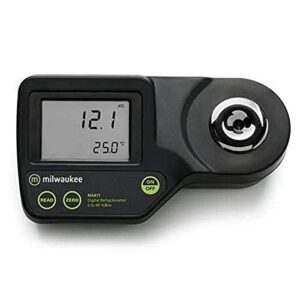
Nobody wants to guess when fruit hits peak sweetness, and that’s where precision tools shine. The Milwaukee Digital Brix Refractometer transforms harvesting techniques by measuring sugar content with scientific accuracy. This device guarantees perfect ripeness assessment during critical harvesting time decisions.
Digital Refractometer Calibration requires only distilled water, while Milwaukee Refractometer Accuracy delivers consistent Brix Level Interpretation across varying temperatures. The automatic temperature compensation eliminates guesswork in vegetable maturity assessment.
| Feature | Specification | Benefit |
|---|---|---|
| Measurement Range | 0-85% Brix | Covers all fruit types |
| Temperature Range | 10-40°C | Works in field conditions |
| Sample Size | 2-3 drops | Minimal fruit waste |
| Accuracy | ±0.2% Brix | Professional-grade precision |
| Calibration | Distilled water | Simple maintenance |
Brix Refractometer Uses extend beyond basic vegetable harvesting—perfect for determining grape ripeness or tomato sugar content. Refractometer Maintenance Tips include regular cleaning and proper storage for longevity.
5. Jevrench Garden Netting Plant Cover
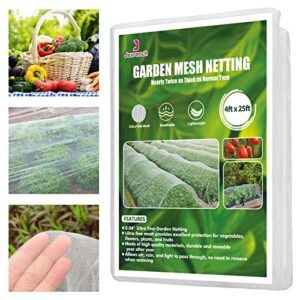
Imagine this: You’ve spent months nurturing your vegetables, only to watch aphids destroy everything overnight. The Jevrench Garden Netting Plant Cover acts as your crop’s bodyguard against such disasters.
This ultra-fine mesh creates an effective barrier for pest protection while maintaining ideal microclimate creation. You’ll appreciate how it allows sunlight, rain, and air circulation without compromising plant health.
The lightweight design won’t crush delicate seedlings, making it perfect for gardening for beginners. Netting installation takes minutes—simply drape over plants and secure edges.
Its reusability factors make it cost-effective across multiple growing seasons. Whether protecting fresh produce like berries or shielding tender greens, this versatile tool supports your optimum harvesting goals by preventing pest damage before it starts.
Best For: Gardeners seeking reliable plant support and protection throughout the growing season.
6. Universal Adjustable Suspension Seat Base
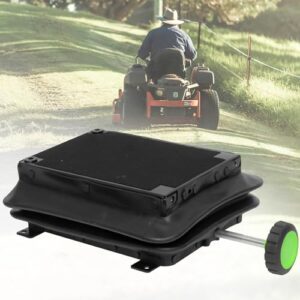
When you’re spending hours on harvesting equipment, Seat Adjustability becomes your best friend for maintaining comfort and productivity.
This Universal Adjustable Suspension Seat Base transforms any bumpy ride into a smoother experience through its Vibration Reduction technology and Suspension Benefits. Built from durable steel alloy, it offers Universal Compatibility with tractors, forklifts, and excavators—essential machinery for large-scale harvesting practices.
The Ergonomic Design includes customizable height and angle settings, plus a protective dust cover that keeps your workspace cleaner during intensive vegetable harvesting techniques.
While installation requires some DIY skills—you’ll need to drill and fabricate brackets—the payoff in reduced fatigue is substantial.
This harvesting guide recommendation particularly benefits operators managing extensive harvesting operations where comfort directly impacts efficiency and long-term health during extended harvesting techniques sessions.
Identifying Ripeness in Various Crops
Knowing when your crops are perfectly ripe can mean the difference between a mediocre harvest and a bountiful one that tastes amazing.
You’ll learn to recognize the visual cues, feel for the right texture, and understand each crop’s unique signals that tell you it’s time to pick, which ultimately leads to a bountiful harvest.
Visual Indicators of Ripeness
Your eyes reveal the secrets of perfect timing through color changes—watch tomatoes shift from green to deep red, while peppers develop their signature brilliant hues.
Size matters when carrots reach thumb-thickness and melons achieve full roundness.
Notice how surface texture transforms from rough to smooth, and shape significance emerges as fruits fill out completely, signaling prime plant maturity indicators for your harvesting guide.
Tactile Indicators of Ripeness
Your hands become powerful tools for detecting peak ripeness through careful touch assessment. Fruit firmness reveals the sweet spot—gently press and feel for slight yielding without mushiness. Vegetable texture tells the story through crispness and structural integrity.
Your touch reveals ripeness secrets that eyes alone might miss—trust your hands to guide perfect harvest timing.
Master these harvesting techniques through tactile evaluation:
- Squeeze test for tomatoes and stone fruits—firm yet responsive
- Root crop feel assessment by tugging gently for resistance
- Leaf squeeze to check springiness and moisture content
- Bean pod pressure to detect filled, plump seeds inside
- Surface smoothness indicating plant maturity indicators
These harvesting best practices transform uncertain guessing into confident selection.
Unique Ripeness Indicators for Specific Crops
Beyond basic visual and tactile cues, each crop offers unique ripeness indicators that reveal ideal harvest timing.
Watermelons develop a creamy yellow belly spot, while cantaloupe reaches "slip stage" when it detaches easily from the vine.
Sweet corn’s silks turn brown and dry, and kernels release milky fluid when punctured. Fruit sugar levels increase in grapes as seeds darken.
Eggplants show glossy skin that springs back when pressed.
These biological markers and crop-specific recommendations help you master precise harvesting techniques for peak flavor.
Cantaloupes are ready to harvest when they reach the slip stage.
Effective Harvesting Techniques for Different Produce
Mastering the right harvesting technique for each type of produce guarantees you’ll get the best flavor, texture, and shelf life from your garden.
Different crops require specific approaches—from gentle hand-picking for delicate berries to strategic cutting methods for leafy greens—and knowing these techniques will transform you from a novice gardener into a confident harvester.
Hand-picking and Cutting Methods
Now that you can identify ripe produce, mastering proper harvesting methods becomes your next step. Hand tools like sharp pruning shears and clippers prevent plant damage while ensuring clean cuts. Tool sharpness directly impacts healing time and reduces disease entry points.
Consider purchasing quality shears for superior results. Morning harvest timing maximizes freshness when plants are fully hydrated. Ergonomic practices reduce fatigue during extended picking sessions. Selective harvesting allows continuous production from the same plants.
Here are three essential harvesting techniques:
- Use sharp, sanitized tools for clean stem cuts that heal quickly
- Support plant stems while cutting to prevent root damage
- Harvest into shallow containers to avoid crushing lower layers.
Damage prevention starts with gentle handling and proper tool selection for each crop type.
Twist and Pull Methods for Fruiting Vegetables
Mastering gentle tugging transforms your harvesting techniques for tomatoes, cucumbers, and peppers.
This method prevents stem detachment damage while ensuring bruising prevention during the ripening stage.
Perfect your approach with these steps:
- Position your hand at the optimal angle near the stem junction
- Apply gentle rotational pressure while supporting the fruit’s weight
- Feel for natural separation—ripe vegetables release easily without force
- Cradle each piece immediately to maintain quality and prevent drops
Loosening Soil for Root Vegetables
Successful soil loosening transforms your root vegetable harvest from frustrating to effortless.
Choose garden forks over shovels to reduce root damage by 21%, while optimum soil moisture 24 hours before harvesting increases yield by 18%. One should also consider optimal harvest times to guarantee peak flavor and nutrition.
| Factor | Impact on Harvest |
|---|---|
| Tool Selection | Garden forks decrease damage 21% vs. shovels |
| Moisture Levels | Pre-watering 24hrs boosts yield 18% |
| Tilling Depth |
20cm depth guarantees complete root removal.
Sandy loam soil composition with proper loosening achieves 96% undamaged potato harvests. These harvesting techniques for root vegetables maximize garden productivity while preventing costly breakage.
Harvesting Leafy Greens and Brassicas
Harvesting leafy greens and brassicas requires proper timing and technique to maximize yield.
Cut-and-come-again methods work perfectly for leafy greens like basil, allowing continuous harvests throughout the growing season.
Here’s your three-step approach to success:
- Early morning harvesting preserves crispness and extends cool storage life
- Staggered planting guarantees continuous harvests while preventing simultaneous bolting
- Proper cutting techniques for broccoli encourage side shoot development.
These harvesting guidelines help you master leafy greens and brassicas effectively.
Post-Harvest Handling and Storage Tips
Once you’ve harvested your crops at peak ripeness, proper handling and storage become critical for maintaining quality and maximizing shelf life.
Your next steps—cleaning, drying, and storing your produce correctly—can mean the difference between enjoying fresh vegetables for weeks or watching them spoil within days.
Cleaning and Drying Produce
Once you’ve gathered your fresh harvest, proper cleaning becomes your first line of defense against spoilage. Gently rinse each item under cool running water, using soft brushes for stubborn dirt on root vegetables. These washing methods remove field contaminants that accelerate decay.
Drying techniques matter just as much—pat delicate produce with clean towels or allow air circulation to eliminate excess moisture. Wet surfaces invite mold and bacteria, shortening vegetable freshness. Sanitation practices include disinfecting all equipment options like baskets and knives before and after use. This might involve specialized commercial washing systems for larger operations.
This careful storage preparation through proper postharvest handling sets the foundation for extended freshness and food safety.
Storage Methods for Different Types of Produce
Proper storage transforms your harvest from garden-fresh to long-lasting treasure. Different crops demand specific Cooling Techniques and Humidity Control to maintain vegetable freshness.
Refrigerate most produce at 32-40°F with 85-95% humidity, but store potatoes, onions, and garlic in cool, dark pantries. Understanding Ethylene Sensitivity prevents premature spoilage—separate ethylene producers like tomatoes from sensitive crops.
One method to extend storage is clamp storage techniques which is suitable for root vegetables with minimal infrastructure.
- Keep apples refrigerated to slow softening ten times compared to room temperature
- Store root vegetables in crisper drawers with high humidity for weeks of freshness
- Maintain Controlled Atmosphere conditions using proper Packaging Solutions for extended shelf life
- Separate ethylene-producing fruits from sensitive vegetables to prevent accelerated ripening
- Use breathable containers and proper ventilation to prevent moisture buildup and decay
Preservation Techniques for Extending Shelf Life
Beyond proper storage, extending your harvest’s lifespan requires smart preservation techniques.
Drying methods like solar dehydrators improve efficiency by 40% over sun-drying, reducing moisture to below 15% for six-month shelf life.
Fermentation benefits include retaining 60-80% of nutrients while creating twelve-month storage without refrigeration.
Canning basics involve pressure or water bath methods, achieving less than 1% spoilage rates yearly.
Ideal conditions often require monitoring humidity with hygrometer for precise control.
| Preservation Method | Shelf Life Extension | Best For |
|---|---|---|
| Controlled atmosphere | 2-5x longer | Apples, pears |
| Freezing produce | 8-12 months | Berries, beans |
| Dehydration | 6+ months | Herbs, tomatoes |
| Fermentation | 12 months | Cabbage, cucumbers |
These postharvest care strategies transform your garden’s bounty into year-round sustenance.
Frequently Asked Questions (FAQs)
How to harvest your crops effectively?
Studies show 30% of harvested crops are lost due to poor timing and handling techniques.
You’ll maximize yields by harvesting during cool morning hours when plants are fully hydrated and using sharp, clean tools to prevent damage and disease spread.
How can I maximize harvest quality & quantity?
Time your harvests during cool morning hours, use sharp tools, handle gently, and immediately cool produce. Harvest at peak ripeness, employ succession planting, and maintain proper storage conditions.
How do I plan my harvest time?
Check your crops daily for maturity signs like color changes, firmness, and size. Use tools like refractometers for sugar content and moisture meters for grains. Harvest during cool morning hours.
What equipment do you need to harvest a crop?
You’ll need sharp pruning shears, harvest knives, sturdy baskets or containers, protective gloves, and measuring tools like refractometers for fruits. Clean, well-maintained equipment guarantees quality harvests and prevents crop damage.
How do farmers determine the best time for harvesting?
Like reading nature’s calendar, you’ll watch for visual cues—color changes, size, and firmness—while checking moisture content with meters and testing sugar levels in fruits for perfect timing.
What should I know about harvesting?
Perfect harvesting requires recognizing maturity signs like color changes, proper firmness, and ideal moisture levels.
You’ll harvest during cool morning hours, use sharp clean tools, handle produce gently, and immediately cool harvested crops to ensure proper handling.
What are the three main methods of harvesting?
Ready to master the art of bringing in your harvest?
You’ll use three main harvesting methods: manual harvesting with hand tools for precision, mechanical harvesting using machinery for large-scale efficiency, and selective harvesting that targets only ripe crops for superior quality.
What time of day is best for harvesting?
Early morning harvesting delivers peak quality—you’ll capture maximum moisture content, cooler temperatures, and ideal firmness. Avoid midday heat that stresses plants and reduces shelf life substantially.
What are the good harvesting practices?
Sharp as a surgeon’s blade, harvesting requires precision and care.
You’ll want to use clean, sharp tools, harvest during cooler morning hours, handle produce gently to avoid bruising.
Transfer crops immediately to shaded areas for maximum freshness and quality.
What are the 4 stages of harvesting?
You’ll progress through pre-harvest assessment, actual harvesting, immediate post-harvest handling, and storage preparation.
Each stage requires careful timing, proper techniques, and quality control to maximize your crop’s value and shelf life.
This process is crucial for the overall quality and shelf life of your crop.
Conclusion
Harvesting your garden isn’t rocket science, but mastering optimum harvesting techniques for beginners transforms amateur gardeners into confident food producers.
You’ve learned timing, tools, ripeness indicators, proper methods, and post-harvest handling.
These techniques guarantee maximum flavor, nutrition, and storage life while maintaining productive plants throughout the season.
Practice these fundamentals consistently, observe your crops carefully, and you’ll develop the instincts needed for successful harvesting every time.
- https://www.frontiersin.org/journals/plant-science/articles/10.3389/fpls.2024.1415297/full
- https://leitesculinaria.com/284894/writings-how-tell-watermelon-ripe.html
- https://harvesttotable.com/how-to-know-when-cantaloupes-are-ripe-slip-stage-and-other-signs/
- https://extension.okstate.edu/fact-sheets/sweet-corn-production.html
- https://spiderfarmer.eu/blog/when-and-how-to-harvest-eggplant/

